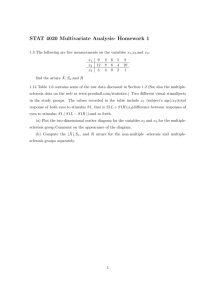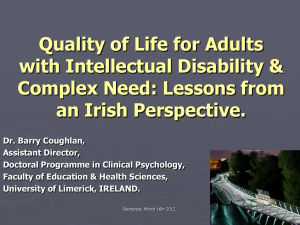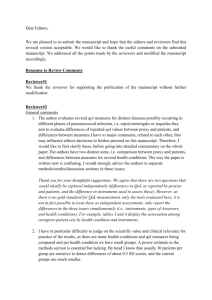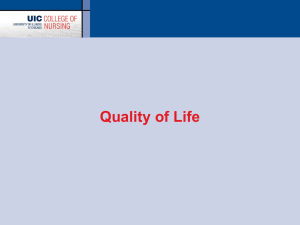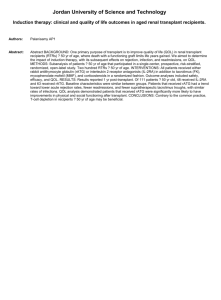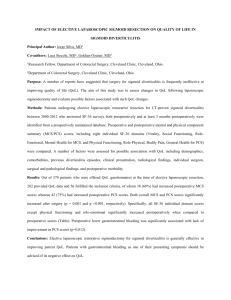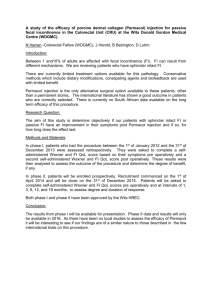HDQoL-C SF user guide - University of Nottingham
advertisement
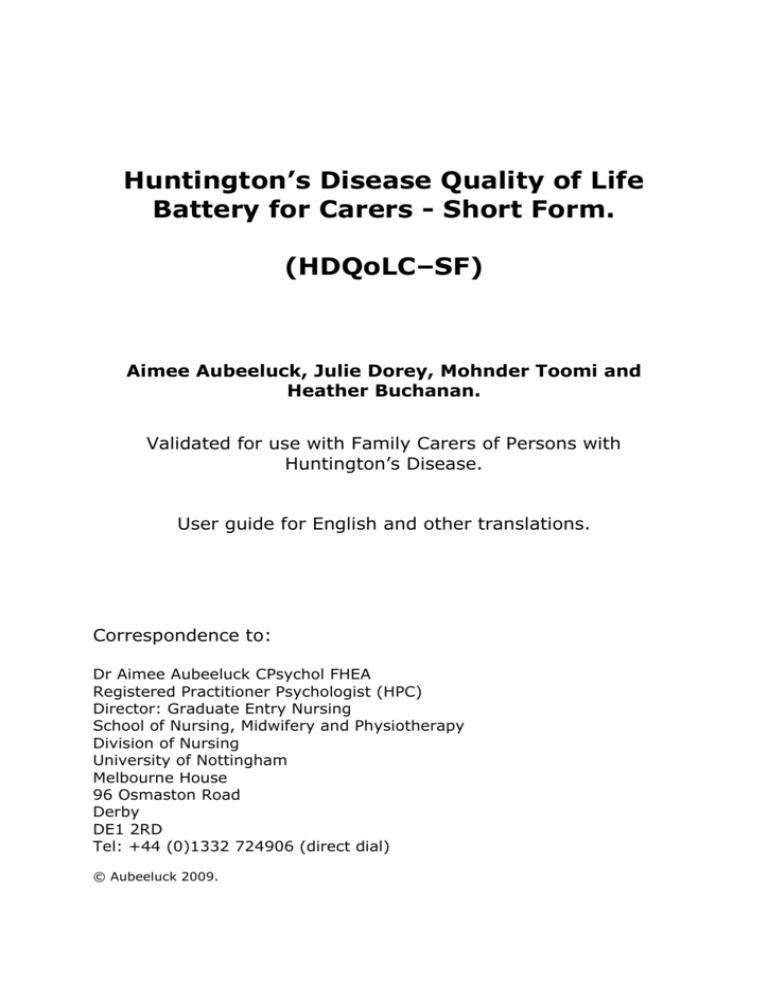
Huntington’s Disease Quality of Life Battery for Carers - Short Form. (HDQoLC–SF) Aimee Aubeeluck, Julie Dorey, Mohnder Toomi and Heather Buchanan. Validated for use with Family Carers of Persons with Huntington’s Disease. User guide for English and other translations. Correspondence to: Dr Aimee Aubeeluck CPsychol FHEA Registered Practitioner Psychologist (HPC) Director: Graduate Entry Nursing School of Nursing, Midwifery and Physiotherapy Division of Nursing University of Nottingham Melbourne House 96 Osmaston Road Derby DE1 2RD Tel: +44 (0)1332 724906 (direct dial) © Aubeeluck 2009. 2 Contents 1 Introduction 1.1 Defining Quality of Life 1.2 Quality of life as an outcome measure. 1.3 Objective of the HDQoLC–SF ……………………………… ……………………………… ……………………………… 3 3 3 Administration General Information ……………………………… 3 3 The HDQoLC-SF ……………………………… 4 4 Calculation of results 4.1 Forms of data analysis 4.1.1 For the practitioner / service provider 4.1.2 For the researcher ……………………………… ……………………………… 7 7 4.1.3 Why calculate percentage scores? ……………………………… 7 4.2 Entering data into a statistical package 4.3 Data Cleaning ……………………………… ……………………………… 8 8 4.4 Dealing with a data skew ……………………………… 8 4.5 Why use an 11 point Likert scale? ……………………………… 8 ……………………………… 9 ……………………………… 18 2 5 6 Psychometric data 5.1 Construction of the HDQoLC-SF 5.2 Reliability References 3 1 1.1 Introduction Defining Quality of life The World Health Organisation (WHO) define Quality of Life as, “….an individual’s perception of their position in life in the context of the culture and value systems in which they live and in relation to their goals, expectations, standards and concerns”. (WHO Group, 1995, pg 3). This is a broad ranging concept which incorporates the individual's physical health, psychological state, level of independence, social relationships, personal beliefs and relationship to salient features of the environment. Furthermore, this definition highlights the view that quality of life refers to a subjective evaluation, which includes both positive and negative dimensions, and which is embedded in a cultural, social and environmental context. The scale that follows is an operationalization of the WHO’s definition of quality of life. 1.2 Quality of life as an outcome measure. Since the 1960’s QoL has been emerging as a useful outcome measure by which to judge the efficacy of psychological interventions (e.g. Cummins, 1997; Rapley, 2003). Using QoL as a measure of outcome focuses on the impact of a condition or situation on the individual's emotional and physical functioning and lifestyle. As such, QoL indicators can assess the subjective benefit of interventions and help to answer the question of whether an intervention leads to an increase in wellbeing by providing a client-led baseline against which its effects can be evaluated (Bowling, 2001). 1.3 Objective of the HDQoLC-SF. The objective of the HDQoLC-SF is to quantify the caregiving experience in Huntington’s Disease (HD). in order to implement and assess interventions. The HDQOLC-SF: (a) Is Multidimensional. The HDQOLC-SF incorporates the individual's psychological state, level of independence, social relationships and personal beliefs in relation to quality of life. (b) Measures QoL from a subjective perspective. The HDQOLC-SF has been developed primarily as an outcome measure i.e. to assess the efficacy of interventions by providing a baseline from which the impact of an intervention can be measured. As such, it does not use the scores obtained as a specific indicator of the QoL that each client is experiencing, but merely as a measure by which to assess whether the client perceives their QoL to be increasing or decreasing when reassessed at a later stage. (c) Has been validated for use with family carers of HD patients. The HDQOLC-SF has been validated for use with family carers of HD patients across Europe. (d) Is psychometrically sound. The HDQOLC-SF is adapted from Huntington’s Disease Quality of Life Battery for carers (HDQoL-C) (Aubeeluck & Buchanan, 2007), a validated and documented QoL tool designed for use with the Spousal Carers of HD patients. The HDQOLC-SF demonstrates good internal consistency, however, it should be noted that the HDQOLC-SF has been validated using a French and Italian population of family carers. It is therefore advisable for the researcher to check the psychometric properties e.g., Cronbach’s alpha coefficient if the scale is used outside Europe or in an additional translation. 2. Administration. 2.1 General information The scale is intended to be self-administered and takes approximately 5 minutes to complete. 4 Huntington’s Disease Quality of Life Battery for Carers Short Form. (HDQoLC–SF) Aimee Aubeeluck, Julie Dorey, Mohnder Toomi and Heather Buchanan. Validated for use with Family Carers of Persons with Huntington’s Disease. User guide for English and other translations. Correspondence to: Dr Aimee Aubeeluck CPsychol FHEA Registered Practitioner Psychologist (HPC) Director: Graduate Entry Nursing School of Nursing, Midwifery and Physiotherapy Division of Nursing University of Nottingham Melbourne House 96 Osmaston Road Derby DE1 2RD Tel: +44 (0)1332 724906 (direct dial) © Aubeeluck 2009. Thank you for taking the time to fill in this questionnaire. The questionnaire will ask you how satisfied you are and how you feel about various aspects of your life. Please answer all the questions. If you are unsure about which response to give to a question, please choose the ONE that seems most appropriate (this is often your initial response). 5 Please circle the number that best describes how satisfied you are with each area of your life. _____________________________________________________________ 1.How satisfied are you with YOUR OWN HAPPINESS? dissatisfied 0 1 2 3 4 5 6 9 satisfied 10 2.How satisfied are you with FEELING A PART OF YOUR COMMUNITY? dissatisfied 0 1 2 3 4 5 6 7 8 9 satisfied 10 3.How satisfied are you with YOUR OVERALL QUALITY OF LIFE? dissatisfied 0 1 2 3 4 5 6 7 8 satisfied 10 7 8 9 Please circle the number that best describes how you feel. _______________________________________________________________ 4. I feel GUILTY never 0 1 5 6 7 8 9 always 10 5. I feel FINANCIALLY DISADVANTAGED never 0 1 2 3 4 5 6 7 8 9 always 10 6. I feel ISOLATED never 0 1 5 6 7 8 9 always 10 7. I feel THERE IS HOPE for the future never 0 1 2 3 4 5 6 7 8 9 always 10 8. I feel EXHAUSTED never 0 1 2 3 4 5 6 7 8 9 always 10 9. I feel SUPPORTED never 0 1 2 3 4 5 6 7 8 9 always 10 10. I feel SAD OR DEPRESSED never 0 1 2 3 4 5 6 7 8 9 always 10 11. I feel STRESSED never 0 1 2 4 5 6 7 8 9 always 10 9 always 10 2 2 3 3 3 4 4 12. I feel WORRIED ABOUT THE GENETIC CONSEQUENCES OF HD never 0 1 2 3 4 5 6 7 8 6 13. I feel MY OWN NEEDS ARE NOT IMPORTANT TO OTHERS never 0 1 2 3 4 5 6 7 8 9 always 10 14. I feel COMFORTED BY THE BELIEF THAT ONE DAY THERE WILL BE A CURE FOR HD never always 0 1 2 3 4 5 6 7 8 9 10 15. I feel THAT HD BROUGHT SOMETHING POSITIVE TO MY LIFE never 0 1 2 3 4 5 6 7 8 9 always 10 16. I feel COMFORTED BY MY BELIEFS never 0 1 2 3 4 5 6 7 8 9 always 10 17. I feel THAT I CAN COPE never 0 1 2 3 5 6 7 8 9 always 10 18. I feel THAT HD HAS MADE ME A STRONGER PERSON never 0 1 2 3 4 5 6 7 8 9 always 10 19. I feel THAT I HAVE HAD A “DUTY OF CARE” FORCED ON ME never 0 1 2 3 4 5 6 7 8 9 always 10 20. I feel LIKE I DON’T KNOW WHO I AM ANYMORE never 0 1 2 3 4 5 6 9 always 10 4 7 8 AND FINALLY, please tell us: What do you think would most improve your quality of life as a caregiver? THANK YOU FOR YOUR TIME. 7 4 Calculation of results 4.1 Forms of data analysis 4.1.1 For the practitioner or service provider The most useful level of analysis may be in terms of component scores rather than an overall QoL score. As such, each area where life quality may be suffering can be monitored individually in line with interventions. Each of the 8 scores can simply be added up to give a Total score. Alternatively if you prefer to work in percentages, use the formula: [(N/10) x 100 = % QoL]. A 100% score would reflect optimum satisfaction with life and represent an optimum QoL. Note: Items 4,5,6,8,10,11,12,13,19 and 20 are all negatively worded and therefore need reversing before scores are totaled (see section 4.2 for further information). Note Make sure all scores that need to be reversed are altered before the scores are totaled. 4.1.2 For the researcher The most useful level of analysis may be the obtained. % overall QoL scores To obtain the overall QoL score: [ (Total score/ 200) x 100 = % Total QoL Score] 4.1.3 Why calculate the percentage scores? The HDQOLC-SF has been developed primarily as an outcome measure i.e. to assess the efficacy of interventions by providing a baseline from which the impact of an intervention can be measured. As such, it does not use the scores obtained as a specific indicator of the QoL that each client is experiencing, but merely as a measure by which to assess whether the client perceives their QoL to be increasing or decreasing when reassessed at a later stage. Therefore, using a lengthy formula is unnecessary and totalling the scores (although this is perfectly acceptable) will only provide abstract numbers for the practitioner or researcher to work with. By calculating percentage scores, the QoL scale becomes an understandable gradient of percentage scores for practitioners and researchers alike to use. 8 4.2 Entering Data into a statistical package. If you are using a statistical package such as SPSS, enter the items using the following procedure: For each of the 20 questions, enter the number that the client has entered. Items 4,5,6,8,10,11,12,13,19 and 20 need reversing. Therefore, for each of these questions an answer of: 0 is reversed to 10 1 is reversed to 9 2 is reversed to 8 3 is reversed to 7 4 is reversed to 6 5 is reversed to 5 6 is reversed to 4 7 is reversed to 3 8 is reversed to 2 9 is reversed to 1 10 is reversed to 0 Note Use the score of 99 to allow computer identification of missing values. If this scheme is used, care needs to be taken that these ‘99’ values are recognized as excluded values, and not included as data. 4.3 Data cleaning It is recommended that the raw data files be carefully examined prior to the implementation of analytic procedures. In particular; (a) (b) Analysis of response frequency data for each variable will allow the researcher to establish that the computer is recognising ‘99’ as a missing variable. The raw data for each client can also be visually scanned to detect patterns of response that are consistently at the top or bottom of the likert scales. Such data should be excluded prior to analysis since they provide no variance and are likely to reflect floor and ceiling effects. 4.4 Dealing with a data skew You may have data that is moderately negatively skewed. To restore normality, a square root transformation can be used. However, opinion is divided among statisticians as to whether this procedure is appropriate. In line with Tabachnick and Fidell (1996), it is not recommended that the data be transformed for the HDQOLC-SF. 4.5 Why use an 11 point likert scale? A major problem with QOL data is their tendency to cluster at the favorable end of any scale (Cummins, 1997). Furthermore, likert scales are often criticized for being unnecessarily restrictive (Fayers & Machin, 2001). Therefore, utilizing an 11 point response should make the Likert methodology more successful as it allows for a wide range of scale levels. 9 5 Psychometric data 5.1 Construction of the HDQOLC-SF The HDQOLC-SF is adapted from Huntington’s Disease Quality of Life Battery for carers (HDQoL-C) (Aubeeluck & Buchanan, 2007), a validated and documented QoL tool designed for use with the Spousal Carers of HD patients. It should be noted that the instrument exists in two parts: 1) Satisfaction with life 2) Feelings about life Both components comprise differing aspects of disease-specific and subjective QoL. 5.2 Internal consistency: Internal consistency was assessed using Cronbach’s Alpha coefficient, which measures the overall correlation between items as well as the level of correlation between items within a scale. Reliability estimates of 0.7 and 0.9 are recommended for instruments that are used in groups and individuals respectively. Both components shows good internal consistency and demonstrate a moderate to strong correlation to the other. HDQOLC-SF Cronbach’s alpha Component 1: Satisfaction with life Component 2: Feelings about life .892 .711 Note: Please contact corresponding author for any further details of item analysis if required. We are continuing to develop and standardise the HDQOLC-SF for use in Britain and globally. It would be most helpful if researchers could send copies of any raw data gathered using the HDQOLC-SF to the corresponding author on diskette or electronically. This will enable us to continue to develop the instrument at national and international levels. Data contributions to any publications will be acknowledged in the usual way. 6 References Bowling, A.., 2001. Measuring Disease. Buckingham, Open University Press. Cummins, R.A. (1997). The Comprehensive Quality of Life Scale (CoMQoL-A5) Manual. Toorak, Deakin University. Kessler, S. (1993). Forgotten Person in the Huntington Disease Family. American Journal of Medical Genetics (Neuropsychiatric Genetics), 48, 145-140. Fayers, P.M., & Machin, D. (2001) Quality of Life: Assessment, Analysis and Interpretation. Chichester., Wiley. Rapley, M. (2003). Quality of Life Research: a critical introduction. London, Sage. Tabachnick, B.G., & Fidell, L.S. (1996). Using Multivariate Statistics. Third Edition. New York, Harper Collins WHOQOL Group. (1995) Quality of life assessment: Position paper from the WHO. Social Science Medicine, 41, 1403-1409.WHOQOL Group (1988). Development of the World Health Organisation WHOQOL-BREF Quality of Life Assessment. Psychological Medicine, 28, 551-558
